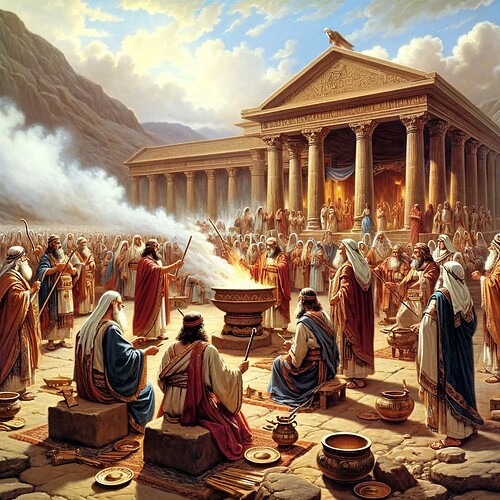![]() February 18: Exodus 29 - Consecration of Priests and Sacred Alter
February 18: Exodus 29 - Consecration of Priests and Sacred Alter
![]() Introduction
Introduction
Exodus 29 is a detailed account of God’s command to Moses about the consecration of the priests. Here, the rituals, offerings, and the process of consecration are illustrated, signifying the importance of a sanctified priesthood for a holy God.
![]() Consecration of Aaron and His Sons: God commands Moses to consecrate Aaron and his sons for them to serve Him as priests. Various offerings, including a bull for a sin offering and two rams for peace and burnt offering, were part of this elaborate ceremony.
Consecration of Aaron and His Sons: God commands Moses to consecrate Aaron and his sons for them to serve Him as priests. Various offerings, including a bull for a sin offering and two rams for peace and burnt offering, were part of this elaborate ceremony.
![]() Key Verse: “Then I will dwell among the Israelites and be their God” (Exodus 29:45).
Key Verse: “Then I will dwell among the Israelites and be their God” (Exodus 29:45).
![]() Key Themes and Reflections
Key Themes and Reflections
The chapter illustrates the demand of God’s holiness. The attire, offerings, and consecration process serve as reminders of the essential separation between God, the Holy, and humans, the sinful.
Consecration is not only about atonement for personal sins but also about community and commitment. Aaron and his sons were consecrated not just for themselves, but to serve the entire nation of Israel.
![]() Today’s Application
Today’s Application
In the life of a Christian, the theme of consecration is still very relevant. Just like Aaron and his sons, we are set apart to serve God. Though we do not require elaborate rituals, our hearts and lives should be offerings pleasing to God.
![]() Hidden Gem
Hidden Gem
This chapter also hints at the enduring presence of God among His people, symbolic of the Christian belief of God dwelling within us.
![]() Reflective Q&A
Reflective Q&A
![]() Why were Aaron and his sons chosen for such significant roles?
Why were Aaron and his sons chosen for such significant roles?
A: Aaron and his sons were chosen as mediators and symbols of the people’s relationship with God. They were set apart to teach and lead the Israelites in their spiritual duties.
![]() What relevance does the consecration of priests hold today?
What relevance does the consecration of priests hold today?
A: While Christians don’t have a designated priesthood, as followers of Christ we are called to offer our lives to God. This involves a self-consecration - committing our thoughts, actions, and lives to His service.
![]() Join the Discussion
Join the Discussion
What do you think about the concept of consecration in your life? How can you offer your life more effectively to God’s service? Share your thoughts.
![]() See you tomorrow in Exodus 30 where we will delve deeper into the significance of the altar of incense.
See you tomorrow in Exodus 30 where we will delve deeper into the significance of the altar of incense.
